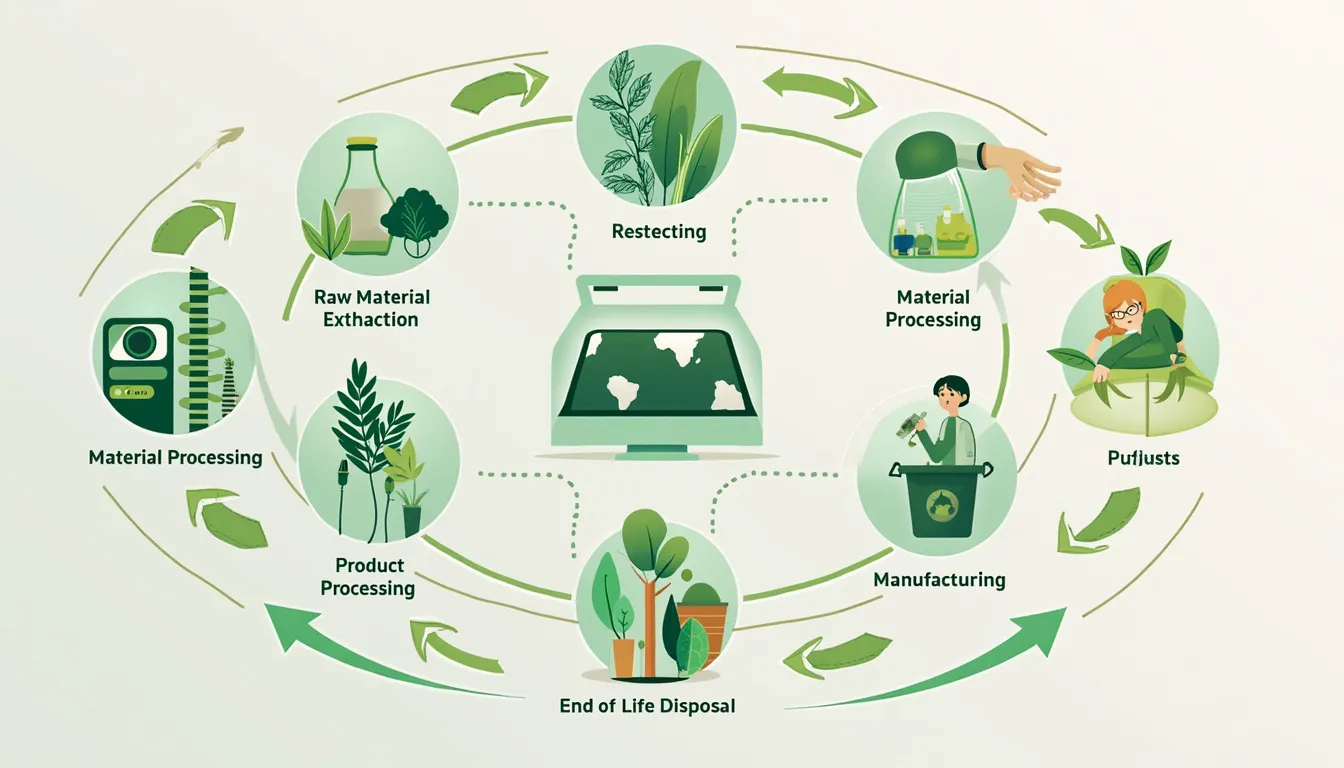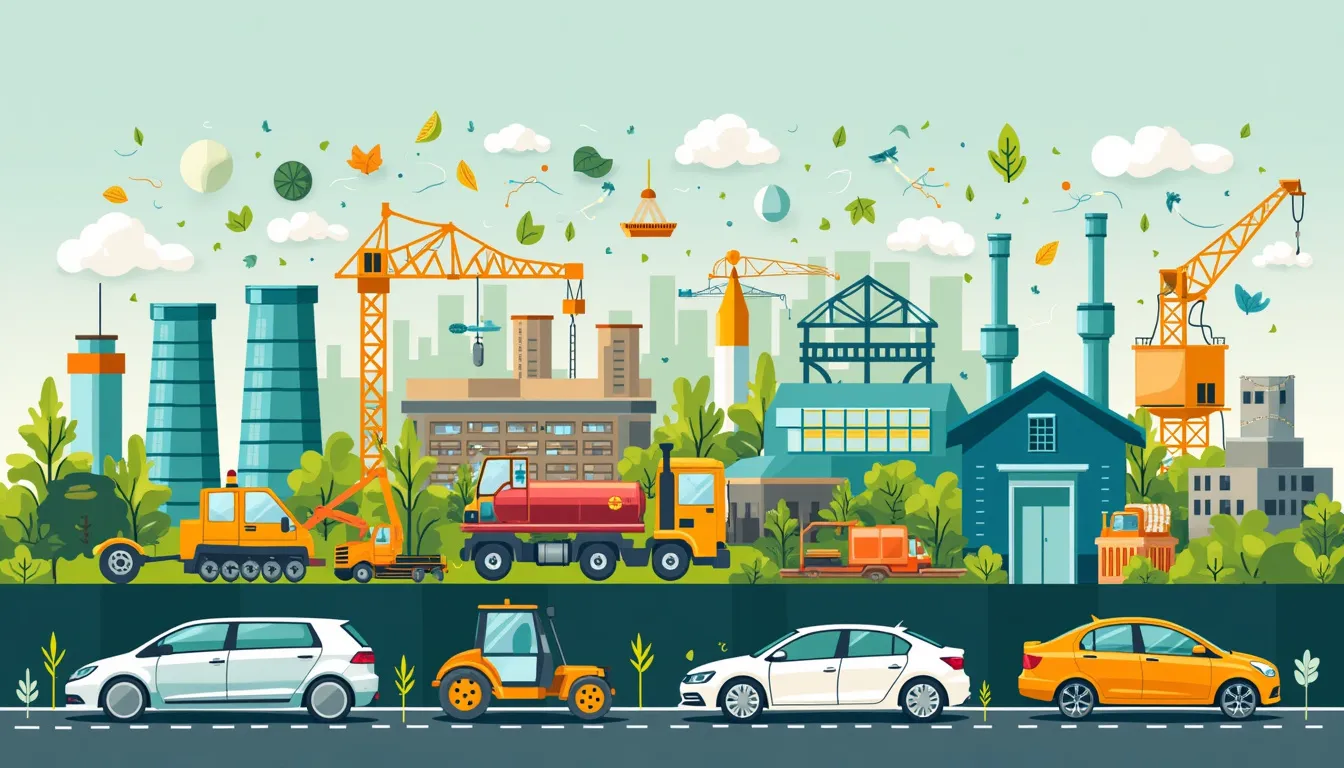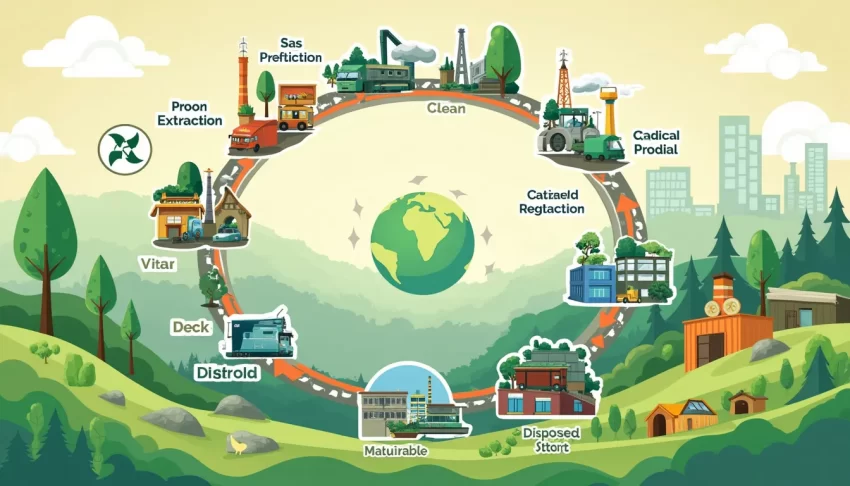In an era where sustainability is becoming more than just a buzzword, understanding and implementing Life Cycle Assessment (LCA) can make a significant difference in how businesses and individuals approach their environmental responsibilities. Life Cycle Assessment, commonly abbreviated as LCA, is a systematic method of evaluating the environmental impacts associated with all the stages of a product’s life from cradle to grave. This includes everything from raw material extraction and processing, manufacturing, and distribution, to use, repair and maintenance, and eventual disposal or recycling.
Why does LCA matter? Well, its importance is multifaceted. For one, a detailed life cycle assessment helps industries pinpoint areas where they can reduce environmental footprints, leading to more sustainable production practices. It’s especially crucial for industries that have historically been heavy polluters, like manufacturing and energy production, but it’s equally relevant for everyday products and services we all use. By examining the entire lifecycle, companies can identify hidden environmental costs and make informed decisions that promote sustainability.
This article will delve into the various phases of life cycle assessment, breaking down the steps involved from setting goals and defining the scope, to conducting inventory analyses, assessing environmental impacts, and interpreting the findings. Understanding these phases will provide clarity on how LCA offers a comprehensive picture of product sustainability.
We’ll also explore real-world applications of life cycle assessment across different industries, illustrating its tangible benefits through case studies. You’ll begin to see how LCA is not merely a theoretical exercise but a practical tool that drives better environmental decision-making, supporting both corporate sustainability goals and broader environmental policies.
Finally, we’ll address the challenges that come with conducting an LCA and the exciting future trends that promise to make the process more accessible and effective. As technology advances, so too do the methods we use to protect our planet, and life cycle assessment is no exception.
By the end of this article, you’ll not only understand the basics of life cycle assessment but also see its critical role in fostering a sustainable future. Whether you’re a business owner aiming to implement greener practices or an individual keen on reducing your carbon footprint, the insights shared here will offer valuable guidance. So, let’s journey through the lifecycle and uncover how each phase can contribute to a more sustainable world.
Introduction to Life Cycle Assessment
Life Cycle Assessment (LCA) is a comprehensive method used to evaluate the environmental impacts of a product, service, or system throughout its entire life cycle. From raw material extraction to manufacturing, distribution, use, and end-of-life disposal, LCA provides a holistic overview of the environmental aspects and potential impacts of a product. By considering all stages of a product’s life, LCA helps identify opportunities for improvement and supports decision-making aimed at reducing negative environmental effects.
The importance of Life Cycle Assessment in various industries cannot be overstated. Whether in manufacturing, construction, agriculture, or technology, understanding the environmental footprint of a product or service is crucial for sustainability. For instance, manufacturers can use LCA to compare different materials and choose the most eco-friendly options, while construction companies can evaluate the long-term impacts of building materials and processes. Likewise, tech companies can analyze the environmental implications of new gadgets, ensuring they are aligned with sustainability goals.
This segment of our article aims to unravel the basics of Life Cycle Assessment by defining its core principles, highlighting its importance across different sectors, and providing a brief roadmap of the comprehensive content that follows. By understanding LCA, individuals and business owners can make more informed decisions that promote sustainability and minimize environmental harm.
At its core, Life Cycle Assessment is both a tool and a methodology. It systematically quantifies the inputs (such as energy, water, and raw materials) and outputs (emissions, waste, and by-products) of every phase of a product’s life. This quantification allows for a detailed analysis of potential environmental impacts, such as greenhouse gas emissions, water use, and resource depletion. Moreover, LCA models and assesses how production processes, product usage, and disposal methods contribute to these impacts.
One of the key strengths of Life Cycle Assessment lies in its ability to reveal hidden environmental costs, which might not be apparent when only considering a single phase of a product’s life. For example, a biodegradable plastic bag might seem like a superior alternative to a conventional plastic bag when only looking at the disposal phase. However, an LCA might reveal that the production of biodegradable plastic requires more energy and water, leading to a larger overall environmental footprint when assessed from a life cycle perspective. This is where LCA proves its worth by providing a more comprehensive understanding of environmental impacts.
Given its extensive applicability, Life Cycle Assessment has become increasingly relevant in policy-making, corporate strategy, and consumer awareness. Governments and regulatory bodies often use LCA to develop environmental standards and legislation. For instance, the European Union employs LCA in its eco-design directives, ensuring that products sold in the market meet specific environmental criteria. In the corporate world, companies use LCA to enhance their sustainability reporting, reduce costs by identifying inefficiencies in their supply chains, and market their products as environmentally friendly. This not only improves their brand image but also meets the growing consumer demand for sustainable products.
As we delve deeper into this article, we will explore the various phases of Life Cycle Assessment, from goal and scope definition to interpretation. Each phase plays a crucial role in ensuring the accuracy and reliability of an LCA study. Understanding these steps will provide clarity on how LCA can be effectively conducted and utilized to drive meaningful sustainability initiatives.
Importantly, we will also look at real-world applications of LCA across different industries. Through examples and case studies, the tangible benefits and insights gained from LCA will become evident. Whether it’s reducing the carbon footprint of a beverage company by optimizing its supply chain or helping a construction firm choose more sustainable materials, LCA proves to be an invaluable tool.
The journey of Life Cycle Assessment doesn’t come without its share of challenges and opportunities for growth. From data availability and accuracy to the complexity of modeling environmental impacts, LCA practitioners face several hurdles. However, advancements in technology, such as the development of sophisticated LCA software and improved data collection methods, are continually enhancing the field.
By highlighting future trends and areas for innovation, we aim to inspire readers to not only understand LCA but also consider how they can contribute to its evolution. Whether by advocating for better data transparency, supporting policy changes, or integrating LCA into their business practices, there are numerous ways to get involved and promote sustainable development.
As we venture deeper into the topic, you’ll discover that Life Cycle Assessment is more than just a technical exercise; it’s a powerful framework that aligns with the broader vision of sustainability. By adopting LCA, we can achieve a balanced approach to economic growth, environmental protection, and social well-being, ensuring a healthier planet for future generations.

Phases of Life Cycle Assessment
Life Cycle Assessment (LCA) is a methodical approach for evaluating the environmental impacts associated with all the stages of a product’s life, from raw material extraction to disposal. The process of conducting an LCA is broken down into four primary phases: Goal and Scope Definition, Inventory Analysis, Impact Assessment, and Interpretation. Each phase is crucial for ensuring that the assessment is thorough, accurate, and actionable.
Goal and Scope Definition
The first phase of a life cycle assessment is setting the foundation for the study through Goal and Scope Definition. This step is critical because it establishes the purpose of the LCA and delineates its boundaries.
Establishing the Purpose: The goal of the LCA must be clearly defined and should address the reasons for conducting the study. For instance, the goal might be to compare the environmental impacts of different product designs, identify stages in the product lifecycle that contribute the most to environmental degradation, or support sustainability reporting for regulatory compliance.
Setting Boundaries: The scope determines the breadth and depth of the LCA. This includes defining the functional unit (the quantifiable measure of the function of the product), the system boundaries (which processes and life stages will be included in the study), and the chosen impact categories (e.g., greenhouse gas emissions, water use, land use). Clearly set boundaries ensure that the LCA is manageable and focused.
A personal reflection from my experience: In a project I managed, the goal was to evaluate the environmental impact of different packaging materials. We set a functional unit of one kilogram of transported goods and system boundaries that included raw material extraction, manufacturing, and disposal. This clarity in goal and scope definition streamlined our entire assessment process.
Inventory Analysis
Once the goal and scope are defined, the next phase is Inventory Analysis, which involves data collection and evaluation of input and output flows within the system boundaries.
Data Collection: This step requires gathering detailed data on all energy and material inputs as well as environmental releases (such as emissions to air, water, and soil) associated with each stage of the product life cycle. Accurate data collection is fundamental for a reliable LCA. Data can come from various sources such as databases, industry reports, and direct measurements.
Data Evaluation: After collecting the data, it’s essential to evaluate and organize it into a life cycle inventory (LCI). The LCI boils down the raw data into a comprehensible format, usually involving data on energy consumption, raw material usage, waste and emissions for each stage of the product’s life cycle.
From my professional experience in environmental consulting, I’ve seen firsthand how comprehensive data collection is both the most labor-intensive and the most critical part of conducting an LCA. For example, when assessing the life cycle of a construction material, the detailed data collection included everything from the raw material extraction process in quarries to the energy used in transportation and the emissions released during manufacturing.
Impact Assessment
After compiling the life cycle inventory, the next stage is the Impact Assessment. In this phase, the collected data is translated into potential environmental impacts.
Impact Categories: This involves grouping the inventory data into impact categories like global warming potential, ozone depletion, acidification, and resource depletion. Each category represents a different form of potential environmental harm.
Characterization and Evaluation: Within each impact category, the contributions of the various inputs and outputs are quantified and evaluated. This helps in identifying which life cycle stages and processes are the most environmentally detrimental. For instance, a high carbon footprint might pinpoint the manufacturing phase as an area needing improvement.
In a memorable project for a renewable energy company, the emphasis was on lowering the carbon footprint of their processes. By characterizing the emissions data, we pinpointed specific stages in their supply chain where carbon emissions were highest and proposed effective strategies to mitigate them.
Interpretation
The final phase of life cycle assessment is Interpretation, where the results from the earlier phases are analyzed and conclusions are drawn.
Identifying Significant Issues: Here, the focus is on analyzing the data to identify the significant environmental aspects that emerged during the LCA. It’s about looking at the results from the impact assessment to understand which life stages or processes contribute most heavily to environmental impacts.
Drawing Conclusions and Recommendations: Based on the identified significant issues, the LCA helps derive actionable insights and recommendations. This could involve suggesting design changes, process improvements, or altered sourcing strategies to reduce environmental impacts.
Ensuring Consistency and Transparency: A critical component of the Interpretation phase is ensuring the consistency of the LCA with the goal and scope defined initially. Transparency is also essential, meaning that all assumptions, decisions, and data challenges should be documented and transparent.
In one impactful consultancy project, the interpretation phase revealed that water use during raw material extraction constituted a major impact category for a food production company. The LCA enabled us to recommend water-saving technologies and alternative raw materials, contributing directly to their sustainability goals.
Understanding these phases—Goal and Scope Definition, Inventory Analysis, Impact Assessment, and Interpretation—not only deepens our comprehension of Life Cycle Assessment but also equips us with the knowledge to apply LCA effectively, be it in personal projects or broader business practices.

Applications of Life Cycle Assessment
Examples of Industries and Sectors Utilizing LCA
Life Cycle Assessment (LCA) is a powerful tool that transcends industry boundaries, offering invaluable insights into environmental impacts across various sectors. In the manufacturing industry, for instance, companies utilize LCA to enhance product design by identifying stages where improvements can be made to reduce resource consumption and emissions. Take the automotive sector: car manufacturers like Toyota and BMW use LCA to assess the environmental impact of vehicles from raw material extraction to disposal, integrating findings into their sustainability programs.
In the food industry, LCA helps in evaluating the ecological effects of food production. Companies like Unilever and Nestlé employ LCA to benchmark the environmental footprint of different foods, guiding them in sourcing more sustainable ingredients and optimizing packaging. Similarly, in the construction sector, firms apply LCA to examine the life cycle of building materials and structures, guiding architects and builders toward eco-friendly designs and sustainable construction practices.
Case Studies Showcasing the Benefits of LCA
To illustrate the transformative potential of Life Cycle Assessment, let’s delve into a few compelling case studies.
**Case Study 1: Coca-Cola’s PET Bottles**
Coca-Cola conducted an LCA of its polyethylene terephthalate (PET) bottles with the goal to diminish environmental impact and promote recycling. The study revealed that producing PET bottles from recycled materials considerably reduced greenhouse gas emissions compared to using virgin materials. As a result, Coca-Cola launched the PlantBottle—a recyclable bottle made partially from plant-based materials—significantly cutting down its carbon footprint and promoting environmental stewardship.
**Case Study 2: Interface Inc.’s Carpet Tiles**
Interface Inc., a prominent manufacturer of modular carpet tiles, leveraged LCA to revolutionize its product offerings. Through LCA, Interface pinpointed the most environmentally damaging phases of its carpet tile production. By transitioning to recycled materials and optimizing manufacturing processes, the company slashed its greenhouse gas emissions and waste generation. Their Mission Zero initiative aims for a zero environmental footprint by 2020, showcasing how LCA can drive ambitious sustainability goals.
**Case Study 3: The Danish Dairy Industry**
In the dairy sector, Arla Foods used LCA to understand the environmental impact of its milk production, revealing the substantial carbon emissions associated with dairy farming. Armed with this knowledge, Arla implemented sustainable farming practices and optimized feed and manure management, successfully reducing emissions. This case study exemplifies how LCA can steer agricultural practices toward environmental sustainability.
How LCA Supports Sustainability and Environmental Decision-Making
Life Cycle Assessment plays a pivotal role in bolstering sustainability and guiding environmental decision-making. By offering a holistic perspective of a product or process’s environmental impact, LCA empowers businesses to make data-driven decisions that favor sustainable practices. For companies striving to reduce their carbon footprint, LCA identifies critical stages in the supply chain where interventions will have the most significant impact.
Moreover, LCA fosters innovation by highlighting opportunities for improvement, whether through material substitution, process optimization, or waste reduction. For instance, Patagonia, an outdoor clothing brand, utilizes LCA to scrutinize the environmental burden of its clothing line. Insights from LCA have led the company to incorporate recycled materials and enhance product durability, reaffirming its commitment to environmental responsibility.
In policymakers’ hands, LCA serves as an evidence-based decision-support tool. Governments and regulatory bodies employ LCA to craft legislation and policies that promote sustainable development. For example, the European Union’s Product Environmental Footprint (PEF) initiative relies on LCA methodologies to create harmonized environmental standards for products, advocating for sustainability across the European market.
Furthermore, consumers are increasingly aware of the environmental implications of their purchasing choices. LCA-driven environmental product declarations (EPDs) provide transparent information about the environmental performance of products, guiding consumers towards more sustainable options. This transparency fosters a culture of accountability and encourages companies to elevate their sustainability practices.
In education, universities and research institutions incorporate LCA into curricula, cultivating a generation of professionals adept at evaluating and mitigating environmental impacts. By equipping students with the skills to conduct LCAs, educational institutions contribute to the global effort to achieve sustainability.
The applications of Life Cycle Assessment are vast and varied, but the common thread is its capacity to illuminate the environmental consequences of human activities, guiding us towards a more sustainable future. By embedding LCA into decision-making processes, industries, governments, and individuals alike can contribute to environmental preservation and sustainability. Whether you’re in manufacturing, food production, construction, or just looking to make a difference in your daily life, understanding and applying LCA can lead to informed, impactful choices that benefit our planet.
Next time you make a purchase or a business decision, consider the entire life cycle of the product or process. Embracing LCA is a step toward a more sustainable and conscientious world, where every choice counts.

Challenges and Future Trends in Life Cycle Assessment
Common Challenges Faced in Conducting LCA
While Life Cycle Assessment (LCA) is a powerful tool for understanding the environmental impacts of products and processes, it is not without its challenges. One of the most prominent difficulties is data quality and availability. Accurate and comprehensive data is crucial for reliable LCA results. However, obtaining precise data for every stage of a product’s life cycle can be extremely difficult. For instance, suppliers may not always have detailed records of their processes, or proprietary information might be withheld for confidentiality reasons.
Another challenge is the complexity of accurately modeling the entire lifecycle of a product. This includes capturing and analyzing the myriad of inputs and outputs that span manufacturing, transportation, use, and disposal. Each phase can have distinct environmental impacts, and the task of compiling and processing this data often requires specialized knowledge and tools.
Additionally, there is the challenge of standardization. Different industries may employ varied LCA methodologies, leading to inconsistencies in results. Even small deviations in assumptions or computational methods can result in significantly different impact assessments, complicating the task of comparing results across studies.
Technological Advancements Aiding LCA Processes
Despite these challenges, technological advancements are making Life Cycle Assessment more accessible and accurate. One of the key developments is the rise of Big Data and advanced analytics. These technologies are enabling the collection and processing of vast amounts of data with unprecedented speed and precision. This means more comprehensive and reliable LCA models can be developed.
Software tools specific to LCA are also evolving, offering greater capabilities and user-friendliness. Programs such as SimaPro, GaBi, and OpenLCA are becoming more sophisticated, incorporating up-to-date databases and faster computing capabilities. These tools assist practitioners in dealing with large datasets, conducting sensitivity analyses, and interpreting complex results.
Machine learning and artificial intelligence are also starting to play a role in enhancing LCA methodologies. By identifying patterns and correlations within large datasets, these technologies can improve the accuracy of predictive models and help identify areas where environmental impacts can be mitigated.
Future Directions and Trends in the Field of LCA
Looking ahead, the field of Life Cycle Assessment is expected to continue evolving. One significant trend is the increased integration of LCA into corporate decision-making processes. Businesses are recognizing the importance of sustainability not just from an environmental standpoint, but also for consumer preference and long-term viability. As a result, LCA is being used to inform product design, supply chain management, and overall corporate strategy.
Another trend is the growing emphasis on social and economic impacts in LCA studies. Traditionally, LCA has focused primarily on environmental effects, but there is a movement towards a more holistic approach that also considers social and economic dimensions. This trend reflects a broader understanding of sustainability that encompasses the well-being of communities and economic fairness.
Finally, the future of LCA is likely to see increased collaboration across borders and industries. Global challenges like climate change and resource depletion require coordinated efforts and the sharing of knowledge and best practices. International initiatives and frameworks, such as the United Nations’ Sustainable Development Goals, are driving this trend, encouraging businesses, governments, and researchers to work together more closely.
As we’ve journeyed through the essential components and applications of Life Cycle Assessment (LCA), it becomes clear that understanding and implementing LCA is not just a technical exercise but a vital practice for promoting sustainability in both our personal and professional lives. From defining the goals and scope of the assessment to meticulously collecting data, evaluating environmental impacts, and interpreting the results, each phase of LCA offers a critical vantage point for understanding the full environmental footprint of products and processes.
Industries across the globe are increasingly harnessing the power of LCA to make informed and responsible decisions. Whether it’s a tech company assessing the impact of its supply chain or a consumer goods manufacturer looking to reduce waste, LCA’s versatility and depth provide valuable insights that drive sustainability forward. The case studies we’ve seen demonstrate the tangible benefits businesses can reap, including cost savings, enhanced brand reputation, and reduced environmental impact.
Despite its many advantages, Life Cycle Assessment also comes with its set of challenges, such as the complexity of data collection and analysis, the need for standardized methods, and the requirement for continuous updates to remain relevant in our rapidly evolving world. Fortunately, technological advancements are addressing some of these hurdles, making LCA more accessible and precise. Emerging trends point towards even more innovative approaches, such as the integration of AI and machine learning, which promise to revolutionize the field further.
In embracing LCA, both individuals and businesses can make substantial strides towards sustainability. If you’re a business owner, consider incorporating LCA into your decision-making processes to identify and mitigate environmental impacts. As an individual, look for products and services from companies that employ LCA, thus supporting businesses that prioritize sustainability.
Here are some actionable tips to get started:
1. **Educate and Train**: Invest time in understanding the basics of LCA and consider training programs for your team.
2. **Start Small**: Conduct a simplified LCA on a specific product or process to get a feel for the methodology.
3. **Engage Stakeholders**: Include suppliers, customers, and employees in your LCA efforts to garner support and insights.
4. **Use Technology**: Leverage LCA software tools and databases to streamline the process and enhance accuracy.
5. **Set Clear Goals**: Define specific sustainability goals and use LCA results to track progress and inform strategies.
By adopting these steps, you can join the growing community committed to making thoughtful, informed choices that benefit both the environment and society. Remember, every effort counts, and together, we can pave the way towards a more sustainable future.
Support Us: Check out our recommended products on Amazon.

